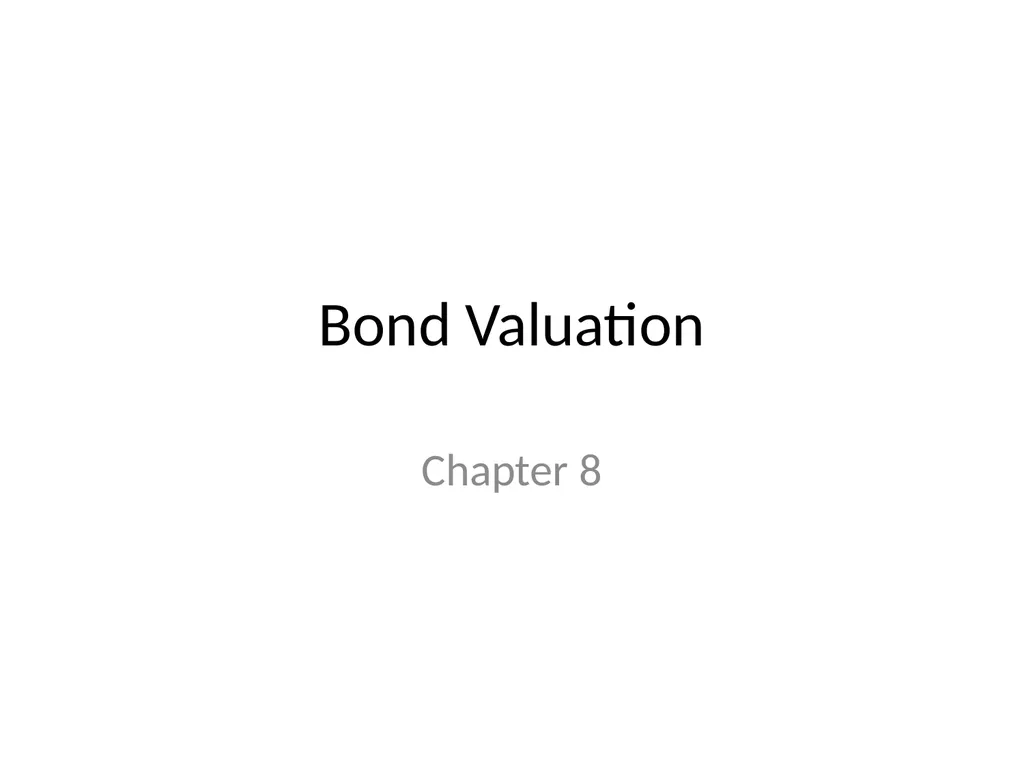Bond Valuation Chapter 8 outline Terminology The
Author : alida-meadow | Published Date : 2025-05-16
Description: Bond Valuation Chapter 8 outline Terminology The Yield to Maturity and Bond Prices Corporate Bonds Further questions Bond Terminology Face value Coupon rate Maturity date Bond Terminology Bonds make two types of payments The promised
Presentation Embed Code
Download Presentation
Download
Presentation The PPT/PDF document
"Bond Valuation Chapter 8 outline Terminology The" is the property of its rightful owner.
Permission is granted to download and print the materials on this website for personal, non-commercial use only,
and to display it on your personal computer provided you do not modify the materials and that you retain all
copyright notices contained in the materials. By downloading content from our website, you accept the terms of
this agreement.
Transcript:Bond Valuation Chapter 8 outline Terminology The:
Bond Valuation Chapter 8 outline Terminology The Yield to Maturity and Bond Prices Corporate Bonds Further questions Bond Terminology Face value Coupon rate Maturity date Bond Terminology Bonds make two types of payments: The promised interest payments are called coupons. These coupons are paid periodically – every six months, annually until the maturity date of the bond. The principal or face value of the bond is the notional amount used to calculate the interest payments. The face value is paid at maturity. Bonds can trade at a price that is greater than (premium), smaller than (discount), or equal to (par) the face value. Coupon payments (CPN) are determined by the coupon rate as follows: Zero-Coupon Bonds zero-coupon bonds have a coupon rate of 0%. Treasury bills (U.S. government bonds with a maturity of up to one year) are zero-coupon bonds Zero-Coupon bonds are also called pure discount bonds since they trade a discount relative to their face value Consider a one year, zero-coupon bond with face value $100,000 and price $96,618.36. The discount reflects the opportunity cost of capital – while the bond pays no “interest” as an investor you are compensated for the time value of money Coupon Bonds Pay face value at maturity and regular coupons throughout the life of the bond Treasury Notes are coupon baring bonds backed by the U.S. Treasury with original maturity of 1-10 years Treasury Bonds are coupon baring bonds backed by the U.S. Treasury with original maturity of over 10 years Coupon Bonds Yield to Maturity and Bond Prices Yield to Maturity The Yield to Maturity of a bond or YTM (or just yield) is the discount rate that sets the present value of the promised bond payments equal to the current market price of the bond. The bond YTM is basically the IRR of the investment in the bond Considering the zero-coupon bond from before: Yield to Maturity What do we learn from the fact that a one-year Treasury bill is trading at YTM of 3.5%? Since the Treasury bill is risk free (the face value is paid with certainty), it must be that the competitive market risk-free interest rate for a one year is 3.5% Yield to maturity of an n-Year Zero-Coupon Bond Calculating Yield to Maturity Yield to maturity of a Coupon Bond with Maturity N Calculating Yield to Maturity of Coupon Bonds This 3% yield is for half














